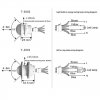Mr. Benson the Technology
New Member
I'm attempting to set up and wire 8 PiR motion sensors, however by the wiring diagram, some of the terms used for some of the wires kind of confuse me a lot.
One brown wire reads off as fire wire and another blue one reads off as null (or zero) wire while the other two, being yellow and secondary blue, connect apparently to a drive(driver) or ballast before connecting to a light, specifically an LED. I have an educated theory of how I would wire them but now I'm just trying to better understand the proper meaning and follow a more step by step wiring diagram so I could make my own from there, could anyone tell me what these names used for these wires mean and how I can go about wiring these sensors but for usages requiring portability. And I haven't even found a proper solution for a power source yet. Please help.
One brown wire reads off as fire wire and another blue one reads off as null (or zero) wire while the other two, being yellow and secondary blue, connect apparently to a drive(driver) or ballast before connecting to a light, specifically an LED. I have an educated theory of how I would wire them but now I'm just trying to better understand the proper meaning and follow a more step by step wiring diagram so I could make my own from there, could anyone tell me what these names used for these wires mean and how I can go about wiring these sensors but for usages requiring portability. And I haven't even found a proper solution for a power source yet. Please help.


